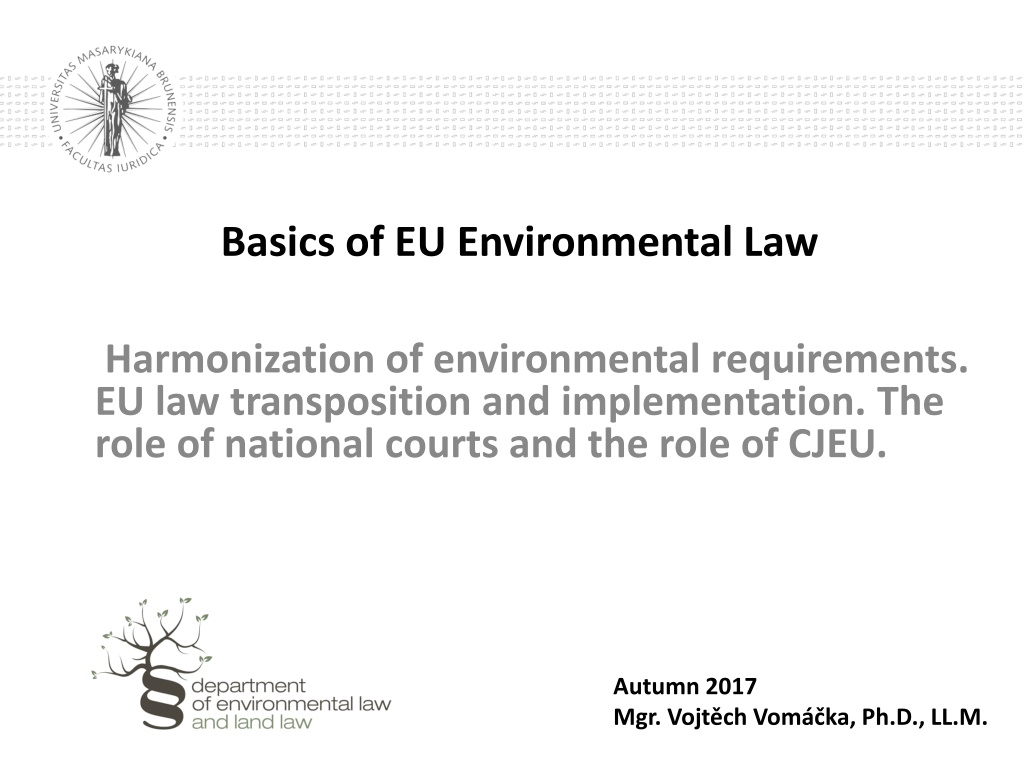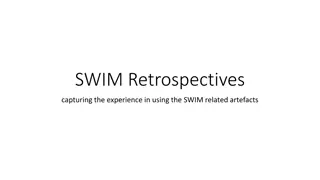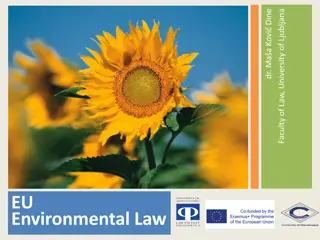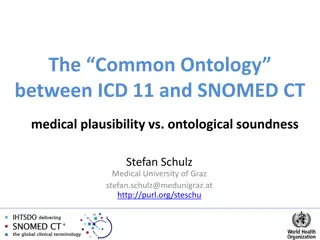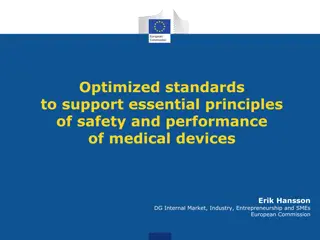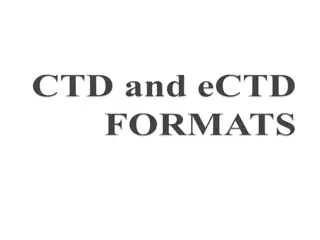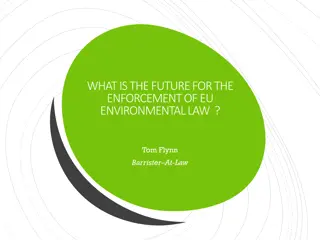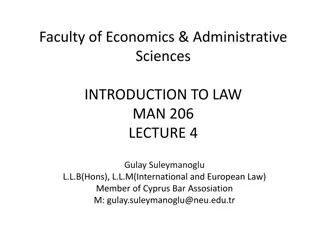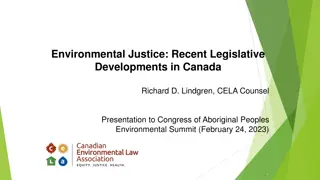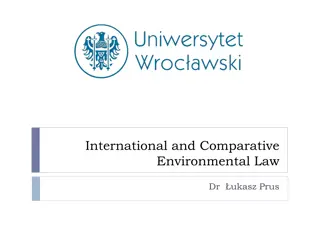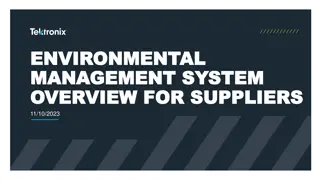Overview of EU Environmental Law Harmonization and Implementation
This document delves into the basics of EU environmental law, highlighting the harmonization of environmental requirements, transposition and implementation of EU laws, the roles of national courts and the CJEU. It emphasizes the essential objective of protecting the environment within the EU framework, detailing primary and secondary legislation, as well as the principles and aims of EU environmental policy. The multi-layered system of enforcement and key principles such as prevention, precautionary measures, and the polluter pays principle are also discussed.
Download Presentation

Please find below an Image/Link to download the presentation.
The content on the website is provided AS IS for your information and personal use only. It may not be sold, licensed, or shared on other websites without obtaining consent from the author. Download presentation by click this link. If you encounter any issues during the download, it is possible that the publisher has removed the file from their server.
E N D
Presentation Transcript
Basics of EU Environmental Law Harmonization of environmental requirements. EU law transposition and implementation. The role of national courts and the role of CJEU. Autumn 2017 Mgr. Vojt ch Vom ka, Ph.D., LL.M.
Last seminar summary Protection of the environment is "one of the Community's essential objectives" which may as such justify certain limitations of the principle of the free movement of goods. Sources: Primary legislation Treaties (TEU, TFEU, Charter) = base for legislation, principles, Secondary legislation regulations, directives, decisions, opinions and recommendations, Conventions and Agreements, Supplementary law
Last seminar summary 1. Secondary legislation: Horizontal legislation, Sectoral legislation 2. Around 1000 pieces of legislation (200 important) targeted at both EU and member states, not a comperhensive system
Characteristics MULTI-LAYERED SYSTEM Where the EU regulation does not specifically provide any specific means of enforcement or refers for that purpose to national laws, regulations and administrative provisions, the Member States are required to take all measures necessary to guarantee the application and effectiveness of EU law. For example, the sanction provided for must be analogous to those applicable to infringements of national law of similar nature and importance, and must be effective, proportionate and dissuasive.
Principles Aims of EU environmental policy: High level of protection Integration Sustainable development (Public participation) Environmental principles (in narrow sense): Prevention The precautionary principle Polluter pays principle Rectification at source
3. Principles 191 (2) TFEU: Community policy on the environment shall aim at a high level of protection taking into account the diversity of situations in the various regions of the Community. It shall be based on the precautionary principle and on the principles that preventive action should be taken, that environmental damage should as a priority be rectified at source and that the polluter should pay. Environmental protection requirements must be integrated into the definition and implementation of other Community policies.
3. Principles - Rectification at source Rectification at source emphasises proximity, opposite to end-of-pipe approach, BAT C-364/03: Accordingly, inasmuch as it is undisputed that emissions of sulphur dioxide and nitrogen oxide have harmful effects on human health and on biological resources and ecosystems, the obligation on Member States to adopt the measures necessary to reduce the emissions of those two substances is not dependent, contrary to the assertion of the Hellenic Government, on the general environmental situation of the region in which the industrial plant in question is located.
3. Principles C-2/90: The principle that environmental damage should as a matter of priority be remedied at source, laid down by Article 130r (2) of the Treaty as a basis for action by the Community relating to the environment, entails that it is for each region, municipality or other local authority to take appropriate steps to ensure that its own waste is collected, treated and disposed of; it must accordingly be disposed of as dose as possible to the place where it is produced, in order to limit as far as possible the transport of waste. (Moreover, that principle is consistent with the principles of self-sufficiency and proximity set out in the Basel Convention of 22 March 1989 on the control of transboundary movements of hazardous wastes and their disposal, to which the Community is a signatory.)
3. Principles Polluter pays Directive 2000/60/EC of the European Parliament and of the Council of 23 October 2000 establishing a framework for Community action in the field of water policy: Member States shall take account of the principle of recovery of the costs of water services, including environmental and resource costs, having regard to the economic analysis conducted according to Annex III, and in accordance in particular with the polluter pays principle.
3. Principles Polluter pays C-254/08 (wide margin of appreciation ): While the Member States as the addressees of Directive 2006/12 are bound as to this result to be achieved in terms of financial liability for the cost of disposing of waste, in accordance with Article 249 EC they may, however, choose the form and the methods to be applied in order to attain that result. as Community law currently stands, there is no legislation adopted on the basis of Article 175 EC imposing a specific method upon the Member States for financing the cost of the disposal of urban waste, so that the cost may, in accordance with the choice of the Member State concerned, equally well be financed by means of a tax or of a charge or in any other manner.
3. Principles Polluter pays C-172/08 - Pontina Ambiente: cost of disposing of the waste must be borne by the waste holders. It forms part of the objective of Directive 1999/31 which, according to Article 1(1) thereof, is to meet the requirements of Directive 75/442, and in particular Article 3 thereof, which inter alia requires the Member States to take appropriate measures to encourage the prevention or reduction of waste production. The consequence, in particular, is that whatever the national rules may be governing landfill sites, they must ensure that that all the operating costs of such a site is actually borne by the holders of the waste deposited in the landfill for disposal. ( ) Causing the operator to bear such charges would amount to charging to him the costs arising from the disposal of waste which he did not generate but of which he merely disposes in the framework of his activities as a provider of services.
3. Principles Polluter pays C-172/08 (Standley) Polluter pays x Proportionality the Member States are to take account of the other sources of pollution when implementing the Directive and, having regard to the circumstances, are not to impose on farmers costs of eliminating pollution that are unnecessary. Viewed in that light, the polluter pays principle reflects the principle of proportionality
3. Principles Prevention Dannish bottles case Various environmental standards. EIA Directive thresholds Usually on legislative level.
3. Principles Precautionary principle Differences: Relevant to the management of risk usually decision-makers = political decision. Uncertainty - where scientific data do not permit a complete evaluation of the risk, recourse to this principle may, for example, be used to stop distribution or order withdrawal from the market of products likely to be hazardous. http://casselsalpeter.com/wp-content/uploads/2012/10/uncertainty_800px.jpg
3. Principles Precautionary principle Where action is deemed necessary, measures based on the precautionary principle should be, inter alia: proportional to the chosen level of protection, non-discriminatory in their application, consistent with similar measures already taken, based on an examination of the potential benefits and costs of action or lack of action (including, where appropriate and feasible, an economic cost/benefit analysis), subject to review, in the light of new scientific data, and capable of assigning responsibility for producing the scientific evidence necessary for a more comprehensive risk assessment.
3. Principles Precautionary principle Joined Cases C-58/10, C-59/10, C-60/10, C-61/10, C-62/10, C- 63/10, C-64/10, C-65/10, C-66/10, C-67/10, C-68/10 (Monsanto, Genetically modified animal feed): It should be borne in mind in this regard that the expressions likely and serious risk must be understood as referring to a significant risk which clearly jeopardises human health, animal health or the environment. That risk must be established on the basis of new evidence based on reliable scientific data.
3. Principles Precautionary principle Time limit x Number of endangered persons x hypothetical risk C-157/96 (National Farmers' Union) C-180/96 (Mad cow disease) http://www.independent.co.uk/incoming/article8882027.ece/alternates/w620/v2web-cjd-getty.jpg bovine spongiformencephalopathy
3. Principles Precautionary principle C-157/96 (National Farmers' Union) Commission Decision 96/239/EC of 27 March 1996 on emergency measures to protect against bovine spongiform encephalopathy An independent scientific body advises the UK Government, concerning the existence of a possible link between BSE) and Creutzfeldt-Jakob disease The plea alleging lack of competence and misuse of powers (disproportionality) existing measures, no evidence What had been prohibited and why?
3. Principles Precautionary principle C-157/96 (National Farmers' Union) ( ) the Community legislature has a discretionary power which corresponds to the political responsibilities given to it by Articles 40 to 43 of the Treaty. Consequently, the legality of a measure adopted in that sphere can be affected only if the measure is manifestly inappropriate having regard to the objective which the competent institution is seeking to pursue
3. Principles Precautionary principle At the time when the contested decision was adopted, there was great uncertainty as to the risks posed by live animals, bovine meat and derived products. Where there is uncertainty as to the existence or extent of risks to human health, the institutions may take protective measures without having to wait until the reality and seriousness of those risks become fully apparent. That approach is borne out by Article 130r(1) of the EC Treaty, according to which Community policy on the environment is to pursue the objective inter alia of protecting human health. Article 130r(2) provides that that policy is to aim at a high level of protection and is to be based in particular on the principles that preventive action should be taken and that environmental protection requirements must be integrated into the definition and implementation of other Community policies.
Implementation and harmonization https://www.youtube.com/watch?v=ypMvDKW5qm0
Content 1) Harmonization of environmental requirements. 2) EU environmental law transposition and implementation. 3) The role of national courts and the role of CJEU.
1) Harmonization of environmental requirements Reasons: Environmental transboundary or global problems (ozone depletion, climate change, biodiversity, air and water pollution, etc.). Market and economy reasons. Avoiding freeruners: same rules, principles and sanctions (existing discrepancies). Lobby and policy, international obligations. and safety reasons: facing
1) Harmonization of environmental requirements Principle of subsidiarity: The objectives of the proposed action cannot be sufficiently achieved by the Member States either at central level or at regional and local level The proposed action by reason of its scale or its effects can be better achieved at Union level Also horizontal dimension - what is the appropriate instrument (regulation/directive) Not a single piece of legislation has been repealed so far. major environmental
1) Harmonization of environmental requirements Principle of subsidiarity: Over these last years, subsidiarity signals a shift away from detailed harmonization and towards a more flexible regulatory style characterized by vague objectives leaving ample room for manoeuvre. In addition, the focus has been placed on negotiated rule-making through soft-law instruments.
1) Harmonization of environmental requirements Principle of subsidiarity: Can you think of any objectives that can be sufficiently achieved by the Member States or cannot be better achieved at Union level? Product safety? For example candles? Production of chemicals? Protection of forests? Protection of endangered species? Environmental rights? Liability?
2) EU law transposition and implementation. Art. 4 (3) TEU: Pursuant to the principle of sincere cooperation, the Union and the Member States shall, in full mutual respect, assist each other in carrying out tasks which flow from the Treaties. The Member States shall take any appropriate measure, general or particular, to ensure fulfilment of the obligations arising out of the Treaties or resulting from the acts of the institutions of the Union. The Member States shall facilitate the achievement of the Union's tasks and refrain from any measure which could jeopardise the attainment of the Union's objectives.
When? C-126/96 (Inter-Environnement Wallonie) The Belgian Conseil d' tat referred to the Court for a preliminary ruling Proceedings brought by an NGO for annulment of the Order of the Walloon Regional Executive on toxic or hazardous waste Part of the Order infringes (?) the EU directives as it excludes from the permit system the operations of setting up and running an installation intended specifically for the collection, pre-treatment, disposal or recovery of toxic or dangerous waste, where that installation forms an integral part of an industrial production process.
2) EU law transposition and implementation. During the period laid for implementation? C-129/96 Since the purpose of such a period is, in particular, to give Member States the necessary time to adopt transposition measures, they cannot be faulted for not having transposed the directive into their internal legal order before expiry of that period. Nevertheless, it is during the transposition period that the Member States must take the measures necessary to ensure that the result prescribed by the directive is achieved at the end of that period. Although the Member States are not obliged to adopt those measures before the end of the period prescribed for transposition, it follows from the second paragraph of Article 5 in conjunction with the third paragraph of Article 189 of the Treaty and from the directive itself that during that period they must refrain from taking any measures liable seriously to compromise the result prescribed.
2) EU law transposition and implementation. During the period laid for implementation? C-129/96 It is for the national court to assess whether that is the case as regards the national provisions whose legality it is called upon to consider. In making that assessment, the national court must consider, in particular, whether the provisions in issue purport to constitute full transposition of the directive, as well as the effects in practice of applying those incompatible provisions and of their duration in time.
C-141/14 (European Commission v Republic of Bulgaria) Article 6(2) and (3) of the Habitats Directive provides: Member States shalltake appropriate steps to avoid, in the special 2. areas of conservation, the deterioration of natural habitats and the habitats of species as well as disturbance of the species for which the areas have been designated, in so far as such disturbance could be significant in relation to the objectives of this Directive. Any plan or project not directly connected with or necessary to the 3. management of the site but likely to have a significant effect thereon, either individually or in combination with other plans or projects, shall be subject to appropriate assessment of its implications for the site in view of the site s conservation objectives. In the light of the conclusions of the assessment of the implications for the site and subject to the provisions of paragraph 4, the competent national authorities shall agree to the plan or project only after having ascertained that it will not adversely affect the integrity of the site concerned and, if appropriate, after having obtained the opinion of the general public.
C-141/14 (European Commission v Republic of Bulgaria) In that respect, it is clear from the Court s case-law that Article 6(2) of the Habitats Directive also applies to installations the project for which was approved by the competent authority before the protection provided for in that directive became applicable to the protection area concerned. Although such projects are not subject to the requirements relating to the procedure for prior assessment of the implications of the project for the site concerned, laid down by the Habitats Directive, their implementation nevertheless falls within the scope of Article 6(2) of that directive.
2) EU law transposition and implementation. Conflicting national law? Annulment Non-application C-41/11 (Inter-Environnement Wallonie II) The referring court can, given the existence of an overriding consideration relating to the protection of the environment, exceptionally be authorised to make use of its national provision empowering it to maintain certain effects of an annulled national measure, in so far as the following conditions are met
2) EU law transposition and implementation. Result: environmental policy is highly decentralised when it comes to implementation and enforcement: The control over its implementation is left, by virtue of Article 192(4) TFEU, to the Member States. Implementation and the enforcement of the EU harmonised measures is entirely left to the Member States control and punishment Decisions as to whether to grant a license for operating a plant, to conduct an EIA, to regulate waste are matters for national, regional and even to local authorities, not for the Commission
2) EU law transposition and implementation. The adequacy of enforcement still remains a major issue The European Commission only exercises a relatively marginal control over the proper implementation of EU secondary law additional control over financing from EU funds Important role of national courts and the role of CJEU.
CONTROL EXCERCISED BY THE COMMISSION Non-communication Non-conformity (non-transposition: delayed, incorrect) Bad application (non-enforcement: no monitoring, no sanctions, non-application) Commission gets information from reports, petitions, complaints, press, previous proceedings EU Pilot: scheme designed to resolve compliance problems without having to resort to infringement proceedings Only a few cases end up before the CJEU.
DIFFERENCES TO GENERAL EU LAW Burden of proof - science comes to play C-335/07, C-438/07
DIFFERENCES TO GENERAL EU LAW Burden of proof - science comes to play 37 The submissions made by the parties indicate that, in general, one of the nutrients, whether it be phosphorus or nitrogen, is present ( ). 38 In such circumstances, it is necessary to adopt different measures to reduce eutrophication in one part of the Baltic Sea as compared with another part. Directive 91/271 provides in this respect that the Member States are to assess, on the basis of the local situation, the substances phosphorus and/or nitrogen which contribute to eutrophication and, in accordance with that assessment, adopt appropriate treatment measures.
DIFFERENCES TO GENERAL EU LAW Systematic failure of a Member State to fulfil obligations C-494/01: waste operation at Fermoy, County Cork
DIFFERENCES TO GENERAL EU LAW C-494/01: in principle nothing prevents the Commission from seeking in parallel a finding that provisions of a directive have not been complied with by reason of the conduct of a Member State s authorities with regard to particular specifically identified situations and a finding that those provisions have not been complied with because its authorities have adopted a general practice contrary thereto, which the particular situations illustrate where appropriate.
DIFFERENCES TO GENERAL EU LAW Consistent and general nature: C-342/05: - Commission has never pleaded a lack of sincere cooperation by the Finnish authorities as regards the communication of decisions relating to the issuing of hunting permits - in spite of the wolf hunting authorised by way of derogation in Finland, the conservation status of the species concerned substantially and consistently improved
DIFFERENCES TO GENERAL EU LAW Systematic failure of a Member State to fulfil obligations how long, how many times C-420/02 Pera Galini site of waste: 4 years: The direct inference may not in principle be drawn that the Member State concerned has necessarily failed to fulfil its obligations under that provision to take the requisite measures to ensure that waste is disposed ( ). However, if that situation persists and leads in particular to a significant deterioration in the environment over a protracted period without any action being taken by the competent authorities, it may be an indication that the Member States have exceeded the discretion conferred on them by that provision. C- 248/05 - While the extracts from the reports quoted by the Commission emphasise the contamination of water supplies, they do not establish to the requisite legal standard a causal link between that contamination and the presence of substances in list II.
Court of Justice (CJEU) Moving the environmental protection further: - Interpretation of EU Law - Procedure Art. 258 260 TFEU - Maastricht Treaty: Financial sanctions - (C-304/02: both lump sum and a penalty payment)
CJEU Article 260 1. If the Court of Justice of the European Union finds that a Member State has failed to fulfil an obligation under the Treaties, the State shall be required to take the necessary measures to comply with the judgment of the Court. 2. If the Commission considers that the Member State concerned has not taken the necessary measures to comply with the judgment of the Court, it may bring the case before the Court after giving that State the opportunity to submit its observations. It shall specify the amount of the lump sum or penalty payment to be paid by the Member State concerned which it considers appropriate in the circumstances. If the Court finds that the Member State concerned has not complied with its judgment it may impose a lump sum or penalty payment on it. This procedure shall be without prejudice to Article 259. 3. When the Commission brings a case before the Court pursuant to Article 258 on the grounds that the Member State concerned has failed to fulfil its obligation to notify measures transposing a directive adopted under a legislative procedure, it may, when it deems appropriate, specify the amount of the lump sum or penalty payment to be paid by the Member State concerned which it considers appropriate in the circumstances. If the Court finds that there is an infringement it may impose a lump sum or penalty payment on the Member State concerned not exceeding the amount specified by the Commission. The payment obligation shall take effect on the date set by the Court in its judgment.
CJEU Moving the environmental protection further: - Interpretation of EU Law - Procedure Art. 258 260 TFEU - Maastricht Treaty: Financial sanctions - (C-304/02: both lump sum and a penalty payment) the seriousness of the infringement, its duration, the need to ensure that the penalty itself is a deterrent to further infringements.
CJEU Seriousness of the infringement: the loss of Community own resources, the impact of the infringement on the way the Community functions, serious or irreparable damage to human health or the environment, economic or other harm suffered by individuals and economic operators, including intangible consequences, such as personal development, the financial sums involved in the infringement, any possible financial advantage that the Member State gains from not complying with the judgment of the Court, the relative importance of the infringement taking into account the turnover or added value of the economic sector concerned in the Member State in question, the size of the population affected by the infringement (the degree of seriousness could be considered less if the infringement does not concern the whole of the Member State in question), the Community s responsibility with respect to non-member countries, whether the infringement is a one-off or a repeat of an earlier infringement (for example, repeated delay in transposing directives in a certain sector).
